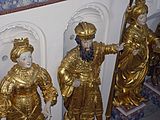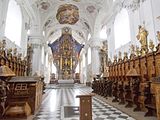Austrian grave (Stams Abbey)

The so-called Austrian grave in Stams Abbey (sometimes also referred to as the Prince's Crypt ) is a monumental work with numerous life-size gilded figures, which is located in the floor of the main nave of the monastery church and, in addition to the stucco and fresco furnishings and the high altar, is one of the special sights of this Cistercian monastery heard.
history
In 1273 Meinhard II , Count of Görz-Tirol , and his wife Elisabeth (widow of Staufer Konrad IV ) founded the Stams Monastery in the Upper Inn Valley as a burial place and memorial church for the Tyrolean sovereigns , after similar Meinhardin-Tyrolean memorial functions from 1259 onwards Parish Church Bozen had existed. In 1480 there was a late Gothic Tumbagrab in the collegiate church , which was only removed in 1680.
In 1552 troops of Elector Moritz von Sachsen plundered the monastery and also destroyed the crypt of the sovereigns as well as the grave of Moritz's brother, Severinus von Sachsen († 1533).
After a fire in 1593, the interior of the church began to be redesigned, and from the 17th to the 18th century the Stams monastery was finally redesigned in the Baroque style . As part of this redesign, the “Austrian grave” was erected between 1681 and 1684 as a central memorial for the sovereigns buried in Stams Abbey by the Tyrolean artist Andreas Thamasch , who created a baroque crucifixion group for this purpose .
The Tyrolean princes buried in the collegiate church are not buried in the “Austrian grave” themselves, but in several tombs sunk into the floor, which are located in the area of the main nave and in the monks' choir on the left and right in front of the high altar. The crypt for Duke Siegmund and his relatives, separated by a metal grille, is located directly behind the “Austrian grave”. The white marble grave slab for the donors and their children with their families is located in the monks' choir in the floor to the left of the high altar, while the white marble slab for Heinrich II and his relatives is in the floor to the right in front of the high altar. The crypt with the grave of Duke Frederick IV , located in the monk's choir between the choir stalls , is closed by an iron grating into which the Austrian shield is incorporated above and the depiction of an eagle from the Tyrolean coat of arms below .
Stams Abbey is not the only burial place of the Habsburgs in Tyrol. Other graves are located in Innsbruck in the Hofkirche , in the St. Jakob Cathedral , in the Dompfarrkirche Bolzano , in the Innsbruck Servite monastery and in the Jesuit church as well as in Hall in the women's collegiate church .
description
Conception
The “Austrian grave” of the Tyrolean artist Andreas Thamasch , which was built in 1684, is embedded in the floor to the west of the collegiate church, in the rear part of the nave, and forms a counterpoint to the main altar. The memorial of the Tyrolean sovereigns buried in Stams, in the architectural form of a confessio , can be reached via a staircase in the west and can be viewed from above from the church. The complex is surrounded by a decorative marble railing on which there are colored coats of arms. Metal grids to the left and right of the altar allow a view of the crypt for Duke Siegmund and his relatives behind the “Austrian Grave” . On the altar of the “Austrian grave” stand the statues of the holy princes Leopold and Wenzel and in wall niches the statues of the princes and princesses buried here. The life-size figures carved and gilded by Thamasch are on plinths in arched niches. In the back corner niches are the smaller sculptures of four princely children. These sculptures are among the first-rate creations of the Tyrolean baroque. Thamasch also created the crucifixion group with Mary and John, as well as a representation of Mary with the child in the collegiate church. Due to its design with life-size portrait figures, Pia Maria Plechl compared the "Austrian grave" with the tomb of Emperor Maximilian I.
List of figures
Life-size gilded statues commemorate the following people who are buried in Stams Monastery:
Installation on the north side (from right to left):
- Meinhard II. (* Around 1238; † 1295) - Count of Görz - Tyrol , founder of Stams
- Elisabeth von Bayern (* around 1227; † 1273) - founder of Stams, wife of Meinhard II, widow of King Conrad IV , daughter of Duke Otto II of Bavaria
- Frederick IV with the empty pocket (* 1382, † 1439) - sovereign from the older Tyrolean line of the Habsburgs
- Anna von Braunschweig (* 1390; † 1432) - 2nd wife of Friedrich IV. With the empty pocket , daughter of Duke Friedrich I of Braunschweig
Installation on the south side (from left to right):
- Heinrich II. (* Around 1265; † 1335) - son of Meinhard II.
- Bianca Maria Sforza (* 1472; † 1510) - 2nd wife of Emperor Maximilian I , daughter of Duke Galeazzo Maria Sforza of Milan
- Sigismund the Coin Rich (* 1427, † 1496) - son of Friedrich IV. With the empty pocket
- Eleanor of Scotland (* 1431; † 1480) - 1st wife of Sigismund the Coin Rich , daughter of King James I of Scotland
On the west side there are niches on both sides of the stairs with a total of four smaller sculptures of unknown princely children.
Picture gallery
"Austrian grave"
North side
South side
see more
Statues of the founders Meinhard II. And Elisabeth of Bavaria
Collegiate church with the “Austrian grave” and the crucifixion group by Andreas Thamasch
Grave slabs in the collegiate church
Grave of Frederick IV in the monk's choir (metal grille in the floor behind the lectern)
Grave slab of the donors Meinhard II. And Elisabeth in the floor left in front of the high altar
Grave slab of Heinrich II. And his relatives in the floor right in front of the high altar
See also
literature
- Brigitta Lauro: The tombs of the Habsburgs. Art monuments of a European dynasty. Vienna 2007, pp. 97-104. ISBN 3-85498-433-2 .
- A prince's dream. Meinhard II. - The becoming of Tyrol. Catalog for the Tyrolean State Exhibition 1995 at Tyrol Castle and in Stams Abbey. Innsbruck 1995.
- 700 years of Stams Abbey 1273–1973. Stams 1973.
- Gert Ammann , Gregor Peda : Stams Abbey (= Small Art Guide No. 289). 2nd edition Schnell and Steiner, Munich / Zurich 1990, ISBN 3-7954-0493-2 .
Web links
Individual evidence
- ↑ a b c d Stams Cistercian Abbey as the burial place of the Tyrolean sovereigns , accessed on September 4, 2014
- ↑ Hannes Obermair : Church and city development. The parish church of Bozen in the High Middle Ages (11th – 13th centuries) . In: The Sciliar . 69th year, issue 8/9, 1995, p. 449–474, reference p. 466 ( academia.edu ).
- ↑ a b c d Anton Prock: Stams Cistercian Monastery ( online) , accessed on September 4, 2014
- ↑ Romedio Schmitz-Esser : Desecration of corpses as a new Gospel: The Stams plundering of the monastery of 1552 and its expression in the historiography of the Cisterce , in: M. Fuchs and R. Rebitsch (ed.): Kaiser und Kurfürst. Aspects of the prince uprising in 1552 (history in the era of Charles V 11). Münster 2010, pp. 139–157.
- ↑ a b c André M. Winter: Fürstengruft in the collegiate church of Stams , accessed on September 4, 2014
- ↑ Pia Maria Plechl : Land of the Mountains. The most beautiful mountain passes and high roads in Austria , Vienna 1973.












